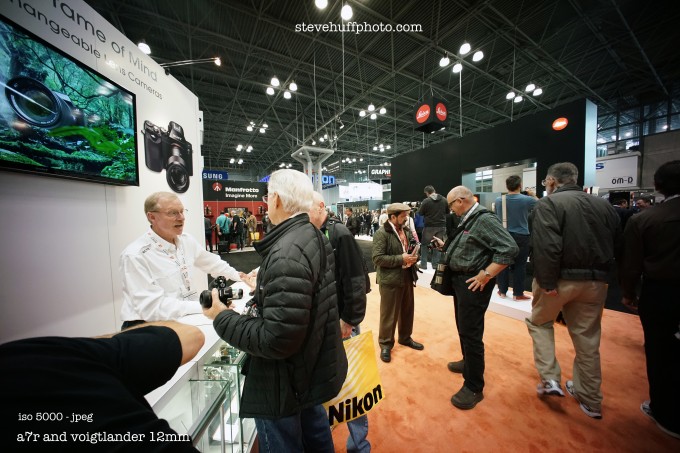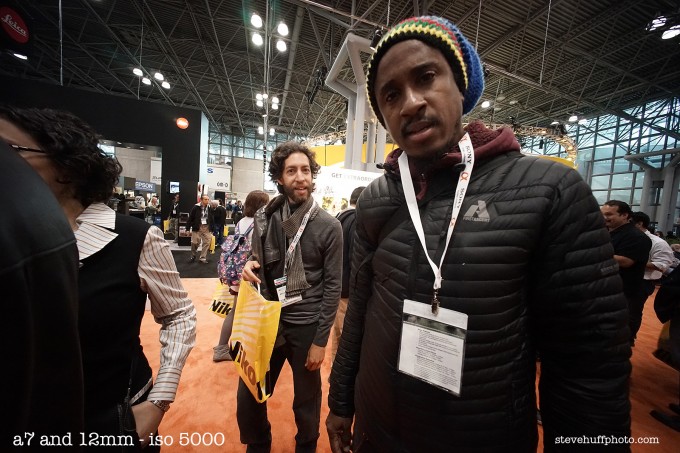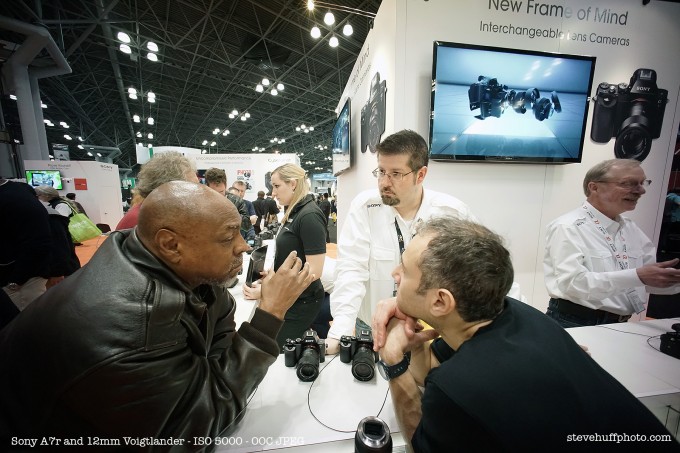| inviato il 25 Ottobre 2013 ore 3:01
peccato che non considerino il problema della vicinanza della lente posteriore ela conseguente incidenza dei raggi sui "bordi" del sensore..
qui trovi tutto lo scibile sui grandangoli, pdf gentilmente offerto da mamma Zeiss
"...tipico delle macchine a telemetro e MIRROR LENS." Una PERLA!!!  |
| inviato il 25 Ottobre 2013 ore 3:01
REVIEW in coreano. interessantissimo: ci sono i jpg e i RAW. Se guardate. al di sotto di ogni immagine, c'e' una label arancione con su scritto JPG o RAW, cliccandoci sopra si scaricano i JPG o i RAW.
Qui un utente di fredmiranda ha convertito i RAW della recensione coreana:
jpg da scaricare "notevoli" ma non impressionanti, sopratutto per quel che riguarda il rumore... comunque senza i RAW e' come parlare di aria fritta...
le lenti utilizzate sono: 55/1.8, 28-70 e 35/2.8
sono state convertite dal RAW con RPP
Sempre da fredmiranda, arrivano notizie interessanti riguardo la conversione con CP1
sembra che con Capture1 le cose vadano decisamente meglio, qui due immagini convertire con CP1
immagine a 100 ISO
immagine 3200 ISO
non conosco CP1, ma a me sembra abbia usato un bel denoise rispetto all'immagine del JPG sfornato da RPP
|
| inviato il 25 Ottobre 2013 ore 8:24
Grazie |
| inviato il 25 Ottobre 2013 ore 8:29
ho fatto copia incolla del post non avevo notato la chicca magari è una nuova tecnologia magari è una nuova tecnologia |
| inviato il 25 Ottobre 2013 ore 15:25
www.ronscheffler.com/techtalk/?p=224
Ho scaricato i file dei test A7 con il 12 ,21,28,35 e 50 Voigtlander e Leica , jpeg elaborati con Lightroom5 e schermo fhd dreamcolor calibrato con spider 3 pro :
il 12 il 21 e perfino il 28 vignettano sensibilmente oltre ad avere un viraggio viola/magenta a tutte le aperture . Correzioni lente possibili, color shift irrecuperabile
35 voigt nokton , vignetta e shifta pure lui a TA , da f2,8 qualche correzione possibile .
Il 50 lux asph a ta presenta color shift agli angoli , si corregge ma il file non viene bene ... si comincia a ragionare da f2.8
Pur sapendo che la A7 non ha le microlenti sul sensore, firmware beta e foto in jpeg ,sinceramente mi aspettavo di piu' soprattutto dal nokton 35 voigt e dal 50 m asph. La mia personale conclusione e' che la A7 vada usata con i suoi obbiettivi.
Attendo fiducioso qualche file di A7r da scaricare
|
user3834 | inviato il 25 Ottobre 2013 ore 15:29
Se non ci fossero stati problemi così evidente non avrebbero fatto la modifica sulla A7r che sicuramente ha un costo a livello produttivo. |
| inviato il 25 Ottobre 2013 ore 15:56
Mi sembra di capire che le ottiche adattate danno qualche problema su A7, dovrebbero andare meglio su A7r? |
| inviato il 25 Ottobre 2013 ore 16:50
Sul lato wide sembrerebbe di sì.... |
| inviato il 25 Ottobre 2013 ore 19:06
riporto un interessantissimo post comparso su fredmiranda forum
---
Hi all,
Back from PhotoPlus from yesterday. I am going to try to fill you in regarding the Sony A7r in this rather lengthy discourse that I am going to try to tie together. If we feel that we should post this elsewhere as well I will.
First let me say that the Sony booth had a whole area set up with fixed lenses with both A7 and A7r cameras available for testing and then another area where there were A7 and A7r cameras set up where lenses could be changed. Unfortunately all of the cameras were pre-production and even though we could load our own lenses providing we had an adapter we were unable to load any memory cards. But even if we had we would have no way of reading the files since the cameras did not have the latest firmware. So, at best, all we could do was to have the opportunity to handle the cameras and to see what would be on the screen.
I spoke to Mike Bubolo, National Manager Photo Specialty for Sales at Sony and he and others at the Sony booth knew that I was there to report back to both this forum as well as to the L-camera-forum regarding the camera. Unfortunately the only M mount lens that I had was the Minolta CLE MC 40mm f2.0 Rokkor-M lens and unfortunately no WA Leica or Zeiss RF lenses. According to Mike, there are actually around 4 or 5 Production cameras that are available for testing (in the US?) and that if I called he could probably get me one to try. But, here in is the rub, even if I get a camera, for the sake of getting a better idea as to the performance of the camera with WA RF lenses I have none available at this time.
As to the camera itself, it is really quite small and light and the camera handled and balanced quite well. The EVF was a big improvement over the one for my Fujifilm X-E1. I believe anyone accustomed to an EVF will be quite pleased. It was bright and very contrasty. I was able to load both M mount and Leica R lenses onto the camera but as I indicated we could not save any images to memory cards. I know that Paul of Phigment Tech will be quite pleased that when we loaded the Phigment Tech Leica M to NEX adapter onto the camera with my Minolta CLE MC 40mm f2.0 Rokkor-M lens the camera immediately recognized the adapter and lens. I did not see any issues and as soon as I adjusted the focus on the lens the camera automatically shifted to magnified view, just as it is supposed to. The only questions that I had about this at the time is where the focusing point was on the screen and whether I could move it or we had to go through the menus to allow for this. At this point I do not recall. When we switched over to the Novoflex Leica R to NEX adapter with my Leica R 24mm f2.8 lens we had some problems. We could not figure out how to get to the magnified view for using the lens but we could access the Focus Peaking and adjust the peaking for different colors. The cameras are so new that almost no one knows their way around the menus and operation. Mike Bubolo of Sony ran over to one of the Sony Tech Engineers and came back with the answer and after going through the menus we were able to find and lock in this option to use the lens.
As to the camera shutter, it was a solid click and perhaps a bit louder than some would like. I asked one of the Sony reps about the comparison in sound with the A7 and he indicated that when using the second shutter it was a little but not that much quieter.
While I was at the Sony booth I also took out my Leica R 280mm f4 Apo Telyt just for size comparison for the camera and no question the lens did look large compared to the camera. I did not load the lens onto the camera, The Sony Rep was impressed by the size of the lens by the way.
As to lenses I spoke with both Richard Schleuning, National Sales Manager for Zeiss and Justin Stailey of Leica Camera USA. Richard told me that the Sony lenses for the A7 and the A7r cameras were being designed and made by Sony. In the case of the Zeiss autofocus lenses that had the Zeiss name on them, these were designed by Zeiss, manufactured by Sony and would go through Zeiss QC checks. When I asked Richard about WA RF lenses for the Sony A7r camera he indicated that they (Zeiss) already knew about the outcome of WA RF lenses used on the camera and regardless of the new Sony 36MP sensor along with the gapless microlenses there were going to be problems with the WA RF lenses. In fact, Richard indicated that there were going to be problems with their own existing RF WA lenses with the camera and sensor. He indicated that this was due to the steepness in the angle for the light rays to reach the sensor. When I asked Richard about the MF lenses that Zeiss was going to make, he indicated that Zeiss had just decided to go forward to make them several days ago and at this point they did not know what focal lengths or the number of lenses that they planned to make (at this time). Richard suggested that lenses would probably be available for show at Photokina next year (2014). He also indicated that the lenses would be coming from Zeiss and not from Sony. He indicated that Zeiss understood the problems of using adapters with lens (and RF lenses) and they were going to look at their existing designs to try to figure out what they would use including possibly Distagon or Sonnar (not Biogon I believe to issues) and that the lenses would have native mounts with the adapter (lengths?) built in and they would have all of the contacts and interaction with these new lenses and with the camera bodies themselves. That way there would be communication between the camera and these new lenses.
Richard Schleuning of Zeiss suggested that only those owning RF WA lenses already lenses should consider using these lenses on the Sony A7r due to the steepness of the angle. He indicated that those that do not have RF WA should not go out and purchase them. Rather he suggested that we either get SLR lenses or better yet wait for the MF lenses that Zeiss had coming in the future. I mentioned to Richard then that SLR lenses would include the Zeiss current line along with their previous generation, as well as the Contax lenses that Zeiss had designed and he agreed.
When I spoke with Justin Stailey of Leica about the Sony A7 and A7r he expressed some concern about the weight of the cameras when used with long lenses (the light weight at the end of tripod mounted lens). Justin also indicated that he had real question about using WA RF lenses and the performance of the A7r even with the gapless microlenses for the new 36MP sensor. Justin indicated that Leica knew all of the ins and outs and problems involved with RF WA lenses used for the M cameras and presumably for the new Sony cameras as well. In fact Justin indicated that he did not think that Zeiss much less Sony knew all of the issues when using WA RF lenses with the M cameras and probably also with the new Sony A7r. Justin indicated that he did not believe that the RF WA lenses wider than 35mm would work well on the new Sony A7r without issues and he expected smearing, vignetting, color issues, etc. would be issues. Justin also seems to have had some question of the performance of the new Sony with even some of the longer Leica M lenses. When I asked Justin the possibility of having Leica make lenses that would fit the new Sony A7 cameras, he indicated that even after the completion of the new Factory in Wetzlar that they would not have enough skilled labor to be able to keep up with the production of their own equipment.
So, there we have it as to using RF WA glass for the new Sonya A7r, we will have to wait for testing of these lenses with the camera and to then decide for ourselves based upon the reported results and what is acceptable for any corrections that can be made for the digital files. We will either have to decide on the lenses that may prove to produce good or better results (with or without additional work), purchase SLR WA glass in the meantime or wait the 11? or more months for the release of the Zeiss MF lenses (and we still have no idea of their designs, size, weight, or cost).
Rich
----
che dire... nulla di piu' di quello che abbiamo discusso in questi giorni 
|
| inviato il 25 Ottobre 2013 ore 19:09
@Bigblock46
nei jpg il color shift e' meno correggibile del RAW, quindi in teoria una piccola speranza rimane...
Quello che proprio non e' possibile correggere e' la mancanza di informazioni su certe lenti... il summicron 28 in certe condizioni appare assolutamente inutilizzabile per lo spappolamento ai bordo.
si, aspettiamo di vedere quanto le microlenti gapless con i condotti fatti apposta per "catturare" meglio la luce dei raggi con maggior angolo di incidenza della A7r facciamo meglio rispetto alla A7... |
| inviato il 25 Ottobre 2013 ore 19:18
Praticamente le ultime 10 pagine di questo post riassunte e tradotte in english!
Leggo spesso il forum fredmiranda che reputo tra i più interessanti ed istruttivi, vedere che sono arrivati alle stesse conclusioni in cui siamo qui non può che confermare la qualità e serietà di questo forum e degli autori di questo post! |
| inviato il 25 Ottobre 2013 ore 19:22
Io oramai aspetto altri test per vedere quali lenti per telemetro saranno utilizzabili su a7r, ma oramai pare chiaro che nel lato wide (che poi è quello che mi interessa di più) bisognerà orientarsi su lenti per reflex adattate o meglio aspettare la buona vecchia Zeiss con le lenti specifiche (anche se non si pronunciano ancora sono sicuro che un wide ed un normale li sforneranno per primi.). |
| inviato il 26 Ottobre 2013 ore 2:48
E' ovvio che offriranno anche un grandangolare, il sistema è appena nato. |
| inviato il 26 Ottobre 2013 ore 4:46
Questa mattina, sveglia presto 
il buon Steve Huff ha postato qualche immagine del voigtlander 12mm... sia su a7r che su A7.
A7r

mi sembra buona, colorshift presente, ma sicuramente eliminabile in postproduzione o con profili lenti... ma non e' a infinito, quindi calma :-)
A7

buona, sembrerebbe che la A7 si comporti meglio della A7r... ma questa foto e' con fuoco "ravvicinato" e quindi e' la condizione migliore in cui la lente posteriroe e' piu' lontana dal sensore... quindi per ora non si possono fare confronti con la A7r
A7r

anche qui un po' di color shift, ma nulla di "troppo" preoccupante... sembra che la A7r si comporti peggio per il color shift rispetto alla A7, ma questa immagine e la precedente non sono alla stessa distanza di MAF, la luce e' estremamente diversa... quindi per ora nessuna conclusione sul confronto A7 vs A7r
Le foto non sono male, ma non dicono nulla sul reale comportamento delle lenti su A7/A7r. NON fatevi pendere dal facile entusiasmo... se va benino sul 12mm, non vuol dire che vada bene sul 15mm o su altre lenti meno "estreme"... tutto dipende dallo schema ottico.
Le foto postate non sono fatte a infinito che e' la posizione piu' critica per quel che riguarda la vicinanza delle lente posteriore al sensore... e un 12mm penso che verra' usato nel 90% dei casi a infinito.... quindi in sostanza niente facili entusiasmi e tanto sangue freddo... a meta' novembre i primi "pazzi" cha hanno ordinato A7/A7r dovrebbero riceverle, quindi presumo saremo sommersi da prove approfondite di ogni ben di dio di lente...
P.S. Il 15mm voigtlnader se non ricordo male sulla M e' un poì piu' problematico del 12mm |
| inviato il 26 Ottobre 2013 ore 19:47
scusate potreste spiegarmi cos'è il color shift? grazie per la pazienza. :-)
|
Che cosa ne pensi di questo argomento?Vuoi dire la tua? Per partecipare alla discussione iscriviti a JuzaPhoto, è semplice e gratuito!
Non solo: iscrivendoti potrai creare una tua pagina personale, pubblicare foto, ricevere commenti e sfruttare tutte le funzionalità di JuzaPhoto. Con oltre 256000 iscritti, c'è spazio per tutti, dal principiante al professionista. |

Metti la tua pubblicità su JuzaPhoto (info) |


 JuzaPhoto contiene link affiliati Amazon ed Ebay e riceve una commissione in caso di acquisto attraverso link affiliati.
JuzaPhoto contiene link affiliati Amazon ed Ebay e riceve una commissione in caso di acquisto attraverso link affiliati.